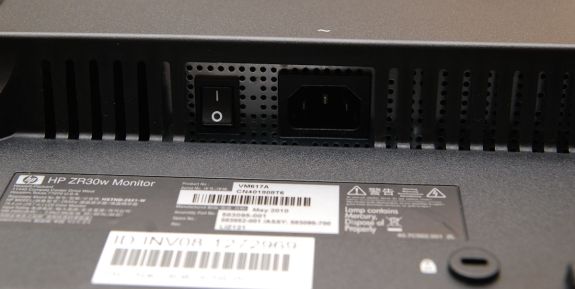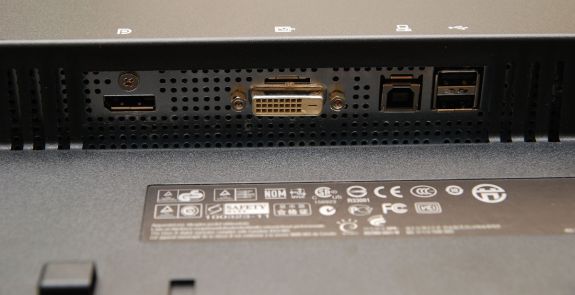A New 30" Contender: HP ZR30w Review
by Brian Klug on June 1, 2010 6:30 PM ESTThe LCD market continues to be one of the frequently updated segments in the consumer electronics segment, as OEMs and vendors alike are eager to bundle their high-end, high performance displays with professional workstations. The ZR30w belongs to that same pro market, offering a 10-bit panel with 1.07 billion colors - for an advertised 99 percent coverage of the AdobeRGB 1998 gamut and 30-bit per pixel color. HP claims that the ZR30w is the first 30" display to break 1 billion colors. When you’re selling a 30” LCD to enthusiasts, every bit of performance matters, and as we’ll show in a bit, the ZR30w doesn’t fail to impress.
As already noted, the ZR30w is targeted primarily at enthusiasts and professionals who demand accurate color tracking and equally large gamut. As with all 30” displays, every detail counts, as this segment represents generally the best of the best for manufacturers. It makes sense, too, since enthusiasts and professionals alike who are serious about getting the absolute largest in display real-estate also care about color tracking and gamut. They expect top performance, and are willing to pay for it. Though similar real-estate can almost be captured with arrays of smaller panels, for most, the 30” segment remains the most lust-worthy among displays thanks to the truly uninterrupted space.
The last 30” HP LCD we touched was the venerable HP LP3065 back in 2007. The LP3065 is still available today as well at $1,349 on HP’s website. The ZR30w is being introduced at a price point of $1,299 - some $300 below Dell’s UltraSharp 3008WFP display. Interestingly enough, the ZR30w does away with the plethora of DVI-D ports we praised the LP3065 for having (almost doubling as a KVM switch). It trims down the 3 DVI-D ports in the LP3065 to 1 DVI-D port and a DisplayPort for the ZR30w. That’s not a deal breaker, but you’re still one input shorter a generation later, which is a bit puzzling. Considering other 30” displays include a plethora of input options, we find the ZR30’s a bit spartan - an HDMI port or component would be welcome additions.
Before we go any further though, let’s dive into the specifications:
| HP ZR30w - Specifications | |||
| Property | Quoted Specification | ||
| Video Inputs | DVI-D, DisplayPort (both with HDCP) | ||
| Panel Type | S-IPS/H2-IPS (CN401808T6 unknown manufacturer) | ||
| Pixel Pitch | 0.250 mm | ||
| Colors | 1.07 billion colors (30 bits) | ||
| Brightness | 370 nits typical | ||
| Contrast Ratio | 1000:1 normal, 3000:1 (dynamic) | ||
| Response Time | 7ms (g2g), 12ms (on to off) | ||
| Viewable Size | 29.7" Diagonal | ||
| Resolution | 2560x1600 (WQXGA) | ||
| Viewing Angle | 178 degrees horizontal and vertical | ||
| Power Consumption (operation) | <130 watts typical, <185 watts maximum | ||
| Power Consumption (standby) | <2 watts sleep | ||
| Screen Treatment | Matte (anti-glare) | ||
| Height-Adjustable | Yes: 4" of travel | ||
| Tilt | Yes: -5 degrees to 35 degrees | ||
| Pivot | No | ||
| Swivel | Yes: -45 degrees to 45 degrees | ||
| VESA Wall Mounting | Yes - 100x100mm | ||
| Dimensions w/ Base (WxHxD) | 27.3" x 19.3" - 23.3" x 10.8" | ||
| Weight w/o Stand | 28.6 lbs | ||
| Additional Features | Integrated 4-port USB hub, HP Quick Release, optional speaker bar | ||
| Limited Warranty | 3 years parts, labor, and onsite service | ||
| Accessories | DVI-D, DisplayPort, USB, and Power Cables | ||
| Price | $1,299.00 | ||
We’ve already talked about the ports, but in case you haven’t used a 30” or equally high resolution panel before, note that dual link DVI is an absolute must. Luckily, HP ships a dual link DVI cable (I’ve seen a few monitors that require dual link DVI actually ship without dual link cables, which always results in a few nightmares) and makes note of it in the instruction manual.
Just don’t expect passive DisplayPort to DVI adapters or other single link DVI interfaces to drive the ZR30w; it won’t work. I experimented with a single link connection just for fun, and the ZR30w refused to show an image. There’s nothing wrong with that, it’s entirely expected. Just be sure you check your cables if things aren’t making sense.

There’s also an internal 4-port USB 2.0 hub. Two ports on the left side of the monitor, two on the bottom near the display inputs. Alongside the standard power connector is a power switch - been a long time since I’ve seen one of those on a monitor.












95 Comments
View All Comments
B3an - Friday, June 4, 2010 - link
Anyone?Brian Klug - Wednesday, June 9, 2010 - link
It depends on what you mean by colors. For real world color gamut, just compare the gamut to the 3008. I don't think we've tested that one yet.Otherwise, this is a 10 bit per channel monitor, so if you have an aware application you can drive more colors.
fenry - Friday, June 4, 2010 - link
The HP LP3065 had lower power specs! These are the numbers from HP:LP3065 ZR30w
176 185 Max Pwr (Watts)
118 139 Typical Power (Watts)
Maybe they mean it's more efficient when it's OFF (<2 Watts).
How do they get away with this being part of their advertising???
I've been paying careful attention to power draw of large monitors from some time, so I am extremely disappointed at HP for this misleading advertising. Check it out for yourself!
xismo - Friday, June 4, 2010 - link
I'm looking forward to the updated review. And honestly the workstation video cards are not that expensive. It's not like you need to get the Quadro FX 5800 to test 10-bit support in photoshop or maya. Like I mentioned earlier almost all of the workstation video cards have native 10-bit support so getting a Quadro FX1800 will actually cost you less or the same as 5870. Also ATI Firepro are generally cheaper and are just as good. NVIDIA hasn't updated their workstation cards for a while, while ATI released one just recently. But obviously if you'd like to get $3000+ high end card like the 5800 I can't stop you :)ProDigit - Saturday, June 5, 2010 - link
I don't care if it's a big screen, I just don't find a lot of justifying a screen that consumes about as much as my common desktop (The EeeBox for instance consumes roughly 20-25W, this screen 150-180W).Personally they would have done better with a LED backlit screen!
The price is also too much!
The last monitor you reviewed was a $300 26" screen, this one is only 4" larger diagonally, and boosts the 1080p resolution to 1600p, but still no reason to be almost $1k more!
Sorry to say, but this monitor is not a good buy; and unless you're busy professionally, you're better off buying 4x $300 26" monitors instead!
jiulemoigt - Sunday, June 6, 2010 - link
Considering even though they are only 10-12 bit displays I would have expected that any monitor claiming to have good color accuracy would be compared to the LCD3090W-BK-SV or LCD3090WQXi-BK.doclucas - Monday, June 7, 2010 - link
HP claim that there is no IC available for 30" is plain bullshit! There are many 30" that come with excellent OSD, such as my Dell 3008WFP (I also own HP LP3065 which I don't like compared to the Dell). Dell still make the best quality (affordable/mainstream) monitors, period.Gilbo - Tuesday, June 8, 2010 - link
Those monitors can implement OSD because they also have scalers.Scalers for 30" monitors have high input lag unfortunately, which makes them less desirable for some people.
CannibalisticH0b0 - Monday, June 14, 2010 - link
My main problem with this review is the inconsistent competitors used for comparison in the tests. The main thing I wanted to compare with other 30" monitors was input lag... yet no 30" monitors were compared with the new HP on that page. I agree that the figure looks low, but it would be nice to have that same exact test done (and shown) with the Dell 3007WFP, for example, which I believe is/was still the king of 30" monitors for gaming.mcklevin - Wednesday, June 16, 2010 - link
I would like to see how this fares against the apple cinema display. I recently purchased and returned the LG 3000H-BN because of a signal defect. However when it did work, I did notice that the anti-glare screen coat was highly distracting at the corners and off angle on a dark screen, especially in a dark room. Is it the same way with this display? In a lit room is a black screen noticeably gray?